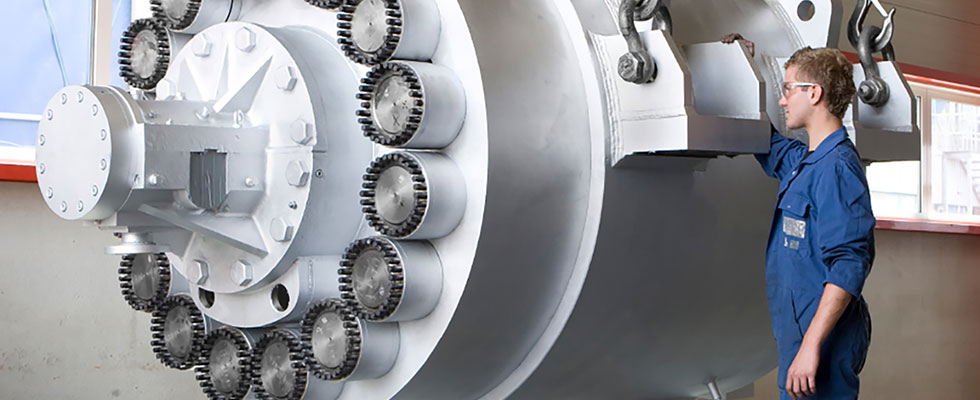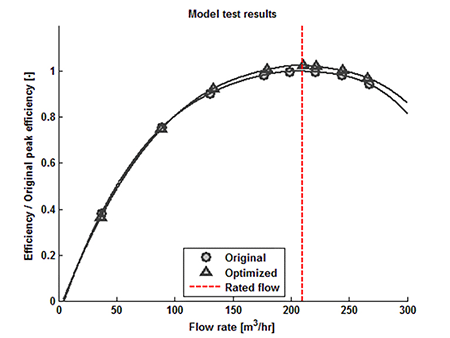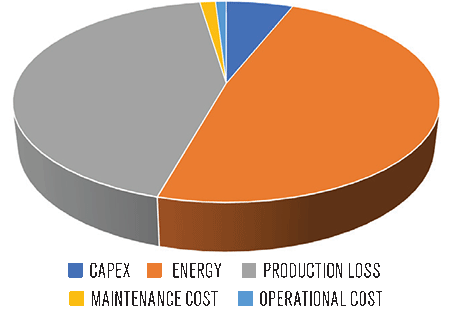
One of the primary internal energy-consuming components in a thermal power plant is the main boiler feedwater pump. Its primary function is the supply of high-pressure water to the boiler that generates steam. Its power consumption is a contributor to overall plant thermal efficiency and operating costs.
Power plant operators can improve thermal efficiency of the overall plant by as much as 0.3% when they optimize the feedwater system. This may sound trivial, but for a 900-megawatt (MW) power plant, this equates to 2.7 MW of additional electrical power that can be supplied to the grid. Here are recommended practices to identify the opportunities on this system:
- Work back from where the hydraulic energy is put to use (the boiler).
- Then, examine how that requirement is controlled (the boiler regulating valves).
- Finally, move on to the boiler feedwater pumps and drive trains that generate the energy and their auxiliaries (e.g., controlled leakage systems).
Steps to Minimize Energy Costs
When purchasing boiler feed pumps, power plant operators and their engineering, procurement and construction (EPC) consultants often prioritize lower capital costs over lower operating costs throughout the total lifecycle.
Increasing energy costs are challenging that business case, prompting plant operators to consider steps to minimize the energy consumption of boiler feed pumps. Rerating a main boiler feedwater pump is a major project that requires thorough planning from all parties.
Pump-optimization project design, engineering and implementation methods are well known. The technologies have been tested and proven over the past half century, but boiler feed pumps are also critical to power generation processes. Taking them offline for the extended periods needed to make modifications can place the plant operator’s ability to meet power demand and production targets at risk.
To ensure project success, it is recommended that plant operators ask the following four key questions to learn options for minimizing energy consumption and successfully lead a pump optimization project.
1. How Big Is the Opportunity?
This is a question plant managers and process engineers often ask.
Combining different solutions at a feedwater system level can improve overall plant thermal efficiency by as much as 0.3%. For a 900 MW power plant, this equates to 2.7 MW of additional electrical power that can be supplied to the grid.
Even if the potential to the boiler feedwater pump is isolated, a minor change in efficiency can present major savings. That can add up to hundreds of thousands or millions of euros or dollars in cost reductions each year in a typical power plant.
Real-world efficiency improvement
A decade ago, a project took place to optimize the design of a 30 MW multistage centrifugal pump installed to supply
boiler feedwater. The complete pump hydraulics were reengineered to improve overall efficiency.
Computational fluid dynamics (CFD) and scale-model tests were used to design changes to individual components, including volutes, short and long crossovers, the suction box and the final discharge.
In a paper presented to the American Society of Mechanical Engineers (ASME), design optimizations were detailed that increased the overall pump efficiency by at least 3%. Years later, the power plant operator continues to report they consistently achieve that rate of efficiency or better.
As a result, this coal-fired, supercritical plant located in the Netherlands has achieved a power consumption reduction of approximately 10,200 megawatt hours (MWh) a year—an estimated financial benefit of €816,000 ($866,257) annually.
Furthermore, improving boiler feed pump efficiency delivered the additional benefit of carbon dioxide (CO2) reduction of an estimated 6,120 metric tons a year. As a result, the power plant operator ensured regulatory compliance and advanced its progress toward the company’s sustainability objectives.
Hydraulic efficiency before and after pump optimization

Energy: The single-biggest cost for critical service pumps

2. What Is the Return on Investment (ROI)?
There has never been a stronger business case for optimizing boiler feed pumps than there is today. Energy costs have been historically low enough that boiler feed pumps could consume parasitic power without a major impact on operations or financial performance. That has all changed because of increasing energy prices and decarbonization goals.
Making the business case for pump optimization
Plant operators want to sell all the power they produce in order to meet business objectives. They also face pricing pressure that challenges their capital and operational expenditures. Boiler feedwater pumps have expected life cycles between 20 to 40 years. During the design and construction of power plants, the pumps typically are purchased at the lowest upfront costs possible for models that meet today’s feedwater requirements. These parameters can change over time as demand increases and power plant operators learn from actual pump performance data.
The original capital expenditure is low—approximately 6%—compared to the total life cycle costs of a boiler feed pump. However, energy to power a boiler feedwater pump can represent up to 50% of the total lifecycle cost. So, anything we can do to rerate a pump that increases its efficiency—even in small increments—can quickly generate major energy cost savings over the long equipment life cycle.
The estimated typical ROI for a boiler feed pump optimization project can be realized in as little as two years. In addition, many nations offer incentives to encourage investments that improve energy efficiency. Some also tax carbon emissions, which further improves the business case for investment in boiler feed pump optimization.
3. What Are the Technical Risks & How Do We Avoid Them?
The power plant operator of the previous example avoided the technical risks of a feedwater pump optimization project that could have delayed the scheduled return to full power production. Meeting the power plant’s optimization project timeline required the reuse of existing pressure boundaries, bearings and mechanical seals.
The changes made in rotor dynamics, incipient net positive suction head (NPSHi) and axial thrust characteristics were first validated through a variety of simulations before the boiler feed pump was removed from service. The expected efficiency improvement was also confirmed from changes to the hydraulic design using scaled model tests and CFD analysis. The study and model testing took one year. The modification of the boiler feedwater pumps were approved after successful completion of the study and model testing.
The final validation of boiler feed pump performance was conducted on-site using thermodynamic testing.
4. Can the Implementation Meet the Outage Schedule?
There should be no hesitation when answering this question.
The boiler feedwater pump supplier must be able to complete upgrades and repairs within the power plant’s scheduled shutdown of critical equipment. There is no time or budget for delays.
A power plant must resume production to meet consumer energy demands and shareholders’ profit expectations. However, power plant operators can minimize the risks inherent in removing a boiler feed pump from service for an upgrade and repairs. Partner with a fluid motion and control provider equipped with resources for engineering, manufacturing, testing, commissioning and aftermarket technical support of its equipment, as well as equipment originally supplied by other OEMs.
Services needed from a pump optimization partner
The optimization partner will need all the capabilities and resources discussed to:
- remove boiler feed pumps from critical service locations
- evaluate the condition of all components
- recommend repair or replacement
- work outside the original project scope, if needed
- redesign components for improved efficiency
- validate design changes through engineering analyses and failure modes and effects analysis (FMEA)
- complete upgrades and repairs in a remote workshop
- use factory testing to confirm that expected efficiency improvements can be realized
- return and commission the pumps on time and within the agreed-upon budget
Optimizing a boiler feedwater system requires thoughtful selection of pump hydraulics to achieve best-in-class peak efficiency considering optimum specific speed. Minimizing boiler-regulating valve throttling requires a data-driven review of actual system requirements and how these are met by throttling and, where applicable, variable speed drive trains. Given the typical system line for this service, these controls need to be validated against a pump’s allowable operating range.
It also can require hydraulic and volumetric losses to be minimized by upgrading the designs and clearances of wear parts and seals.


